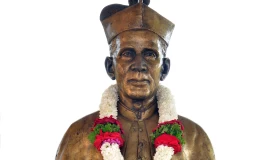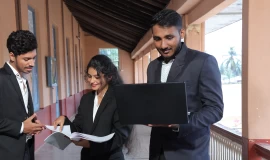Programme Outcomes (POs)
PO1. Critical Thinking: Take informed actions after identifying the assumptions that frame our thinking and actions, checking out the degree to which these assumptions are accurate and valid, and looking at our ideas and decisions (intellectual, organizational, and personal) from different perspectives.
PO2. Effective Communication:Speak, read, write and listen clearly in person and through electronic media in English and in one Indian language, and make meaning of the world by connecting people, ideas, books, media and technology.
PO3. Social Interaction:Elicit views of others, mediate disagreements and help reach conclusions in group settings.
PO4. Effective Citizenship:Demonstrate empathetic social concern and equity centered national development, and the ability to act with an informed awareness of issues and participate in civic life through volunteering.
PO5. Ethics:Recognize different value systems including your own, understand the moral dimensions of your decisions.
PO6. Environment and Sustainability:Understand the issues of environmental contexts and sustainable development.
PO7. Self-directed and Life-long Learning:Acquire the ability to engage in independent and life-long learning in the broadest context socio-technological changes.
Programme Specific outcome (PSO):
PSO1. Apply functional knowledge to assess business problems, identify, formulate, and solve business problems using appropriate methodologies and tools.
PSO2. Develop integrative solutions that improve business outcome.
PSO3. Show how operating in a global market creates new business opportunities.
PSO4. Express ideas clearly and logically in oral and written formats.
PSO5. Recognize ethical and social responsibility issues in business.
PSO6. Work effectively with a spirit of cooperation and communicate effectively by presenting complex information in a clear and concise manner orally, on paper and using ICT.
PSO7. Able to demonstrate information technology skills, especially in the areas of information retrieval, literature searching and library databases.
PSO8. Undertake applied work and research projects in Business Administration.
PSO9. Use opportunities for continuing professional education to enhance their professional development.
PSO10. Acquire knowledge, skills and attitude to become more suitable for the present and emerging employment market.
Course Outcomes of the Course “Business Environment and Entrepreneurship”
CO1. Understand meaning and factors influencing business, social responsibility of business, business ethics and environment.
CO2. Analyze the various types of business entities operating in public, private and cooperative sectors.
CO3. Describe the need for CSR for business and emerging trends on CSR of business in India.
CO4. Define consumerism, its need and objectives.
CO5. Understand the importance of Consumer Protection Act.
CO6. Possess the knowledge on impact of LPG on Indian business sector.
CO7. Discuss the meaning of entrepreneur and entrepreneurship.
CO8. Analyze the role of entrepreneurship in economic development and the barriers to entrepreneurship.
Course Outcomes of the Course “Organizational Behaviour”
CO1. Understand the development of the subject matter.
CO2. Explain personality traits and determinants of personality.
CO3. Describe different types of attitudes and factors which help to develop positive attitudes.
CO4. Apply different motivational techniques.
CO5. Learn how to work in groups and relationship with group & organizational hierarchy.
CO6. To develop inter personal relationship among individuals.
CO7. To manage stress, and its remedies.
CO8. To develop future projects and help to understand future challenges.
Course Outcomes of the Course “Business Statisitcs and Mathematics”
CO1. Analyse the primary data, its collection methods and sources of secondary data.
CO2. Prepare the tables in order to findout the measures of central tendency.
CO3. Acquire knowledge on the various statistical techniques like range, mean deviation, standard deviation and their relative measures.
CO4. Define correlation and regression.
CO5. Prepare correlation table by using Karl Perason’s coefficient correlation and Spearman’s rank correlation coefficient.
CO6. Define basic terms in the areas of business calculus and financial mathematics.
CO7. Explain basic methods of business calculus, types and methods of interest account and their basic applications in practice.
CO8. Connect acquired knowledge and skills with practical problems in economic practice.
Course Outcomes of the Course “Marketing Management”
CO1. Formulate a marketing plan including marketing objectives, marketing mix, strategies, budgetary considerations and evaluation criteria.
CO2. Write a business plan for an entrepreneurial start-up venture.
CO3. Develop strategies for the efficient distribution of products and services.
CO4. Apply the principles of business ethics and corporate social responsibility.
CO5. Develop pricing strategies that take into account perceived value, competitive pressures and corporate objectives.
CO6. Determine strategies for developing new products and services that are consistent with evolving market needs.
CO7. Evaluate the viability of marketing a product or service in an international market or markets and results of marketing activities using criteria related to budgeted sales, costs and profits.
CO8. Communicate marketing information persuasively and accurately in oral, written and graphic formats.
Course Outcomes of the Course “Income Tax”
CO1. Understand the income tax procedure and its sources.
CO2. Apply basic tax concept to simple fact situations.
CO3. Understand the calculation of tax liability.
CO4. Understand all basic concept of income taxation.
CO5. Understand the procedure and methods of calculating business and profession.
Course Outcomes of the Course “Corporate Accounting I”
CO1. To have an understanding on the regulation regarding the formation of the company.
CO2. To have a knowledge on guidelines and procedures regarding the redemption of preference shares and preparation of the final statement after the redemption of preference shares.
CO3. Calculate the profit prior to incorporation and treatment of the pre incorporation profit.
CO4. Calculate the value of right share, understanding of the methods of valuation of shares and goodwill.
CO5. Preparation of final accounts of joint stock company as per the latest norms of the Companies Act.
Course Outcomes of the Course “Executive Development and Soft Skill”
CO1. Develop interpersonal relationship skills.
CO2. Enhance communication skills and presentation skills.
CO3. Understand organisational goal setting and delegation of authority.
CO4. Understand individual’s potentials and deficiency in order to achieve organizational objectives.
Course Outcomes of the Course “Computer Application in Management”
CO1. Understand basics of computer and computer networking.
CO2. Develop information system and its communication through data processing.
CO3. Understand MIS and its implications on the organizational development.
CO4. Facilitate digital system in the office functioning.
Course Outcomes of the Course “Human Resource Management”
CO1. Understand basic concepts of HRM.
CO2. Able to develop human resource planning system for any organization.
CO3. Contribute to the development, implementation, and evaluation of employee recruitment, selection, and retention plans and processes.
CO4. Understand performance appraisal and salary administration.
CO5. Present and evaluate communication messages and processes related to the human resources function of the organization.
CO6. Manage own professional development and provide leadership to others in the achievement of ongoing competence in human resources professional practice.
CO7. Facilitate and communicate the human resources component of the organization's business plan.
CO8. Conduct research, produce reports, and recommend changes in human resources practices.
Course Outcomes of the Course “Fundamentals of Financial Management”
CO1. Understand fundamentals of Financial Management.
CO2. Prepare capital budgeting for a given project.
CO3. Techniques of accumulating capital optimally.
CO4. Manage profits of the company along with the payment of dividend or retained earnings.
Course Outcomes of the Course “Corporate Accounting - II”
CO1. Understand mergers and acquisition of corporate companies.
CO2. Understand and re organize the financial structure of the company.
CO3. Facilitate liquidation process and preparation of final statement of accounts.
CO4. Understand the concepts of minority interest , majority interest and preparation of consolidated balance sheet.
Course Outcomes of the Course “Human Resource Management”
CO1. Contribute to the development, implementation, and evaluation of employee recruitment, selection, and retention plans and processes.
CO2. Administer and contribute to the design and evaluation of the performance management program.
CO3. Develop, implement, and evaluate employee orientation, training, and development programs.
CO4. Facilitate and support effective employee and labour relations in both non-union and union environments.
CO5. Research and support the development and communication of the organization's total compensation plan.
CO6. Collaborate with others, in the development, implementation, and evaluation of organizational and health and safety policies and practices.
CO7. Research and analyze information needs and apply current and emerging information technologies to support the human resources function.
CO8. Develop, implement, and evaluate organizational development strategies aimed at promoting organizational effectiveness.
Course Outcomes of the Course “Commercial Law”
CO1. Understand source and origin of law.
CO2. Understand contract and its implications.
CO3. Form valid offer and acceptance.
CO4. Form understanding about lawfull consideration.
CO5. Understand eligibility to enter into a contract.
CO6. Know different modes of discharge of contract.
CO7. Understand remedies to breach of contract, contract of agency and its conditions.
CO8. Know about RTI Act and Cyber Law and law governing Patents.
Course Outcomes of the Course “Marketing Research”
CO1. Introduce various types of surveys techniques.
CO2. Understand how to prepare a questionnaire.
CO3. Review sample questions.
CO4. study the data collection techniques.
CO5. Understand the concept of consumer behavior, analyze the importance of consumer behavior in the modern marketing era.
CO6. Prepare modules for the marketing strategy.
Course Outcomes of the Course “Financial Management”
CO1. Analyze financial statements using standard financial ratios of liquidity, activity, debt, profitability, and market value.
CO2. Apply techniques to project financial statements for forecasting long-term financial needs.
CO3. Explain the role of short-term financial management, and the key strategies and techniques used to manage cash, marketable securities, accounts receivable and inventory.
CO4. Identify the major sources of short-term financing available to the firm.
CO5. Apply future value and present value concepts to single sums, mixed streams, and annuities, time value, risk, and return concepts and valuation techniques to bonds.
CO6. Identify relevant cash flows for capital budgeting projects and apply various methods to analyze projects.
CO7. Apply the concept of risk, its measurement for single assets and portfolios, various types of risk, the source and use of betas, and the CAPM and SML.
CO8. Apply techniques for estimating the cost of each component of the cost of capital.
Course Outcomes of the Course “Cost Accounting”
CO1. Define the concept of cost , expenses, losses and revenue.
CO2. Explain the relationship between financial and cost accounting.
CO3. Prepare production cost statement and cost of goods sold statement.
CO4. Calculate the inventory cost and evaluation of cost.
CO5. Calculate labour cost to maintain the research.
CO6. Calculate overhead cost and analyse.
CO7. Understand the absorption of overhead cost and prepare the statement of absorption by using simultaneous equation method.
CO8. Calculate cost on running the machine in the factory.
Course Outcomes of the Course “Export Management”
CO1. Understand the concept of international trade, its benefits and the concept of BOP.
CO2. Describe the various export promotion agency and its functions.
CO3. Understand the procedure involved in the management of export business and various documents required in the process of export of goods.
CO4. Define international marketing system and analyze the problem involved in the export marketing.
CO5. Analyze the export pricing and its objectives and importance.
Course Outcomes of the Course “Event Management and Public Relations”
CO1. Analyse and evaluate appropriate business strategies, practices and theories that inform and guide organization to ensure sustainability.
CO2. Manage the scope, cost, timing, and quality of the project, at all times focused on project success as defined by project stakeholders.
CO3. Adapt projects in response to issues that arise internally and externally.
CO4. Implement general business concepts, practices, and tools to facilitate project success.
CO5. Utilize technology tools for communication, collaboration, information management, and decision support.
Course Outcomes of the Course “Company Law”
CO1. Understand different types of company and its structure.
CO2. Facilitate formation of company and its legal implication.
CO3. Understand different kinds of shares and share capitals.
CO4. Understand role of company secretary and its qualification.
CO5. Manage company meetings and appointment of its chairman.
Course Outcomes of the Course “Investment Management”
CO1. Get knowledge related to types of investment and risk involved in it.
CO2. Analyse fundamental and technical analysis of the company.
CO3. Get knowledge on types of financial market and speculators involved in it.
CO4. Define benefits of mutual funds and measurement of the performance.
CO5. Facilitate knowledge over portfolio management.
Course Outcomes of the Course “Cost and Management Accounting”
CO1. Understand methods of costing.
CO2. Familiarize contract costing and process costing.
CO3. Demonstrate cost analysis techniques and break even analysis.
CO4. Analyse budgets and budgetary control techniques.
CO5. Apply standard costing techniques.
Course Outcomes of the Course “Auditing”
CO1. Understand classification of audit and techniques of auditing.
CO2. Facilitate effective internal control in the organisation.
CO3. Familiarize vouching procedure in auditing.
CO4. Demonstrate verification of assets and liabilities and its valuation.
CO5. Explain role of company auditor and its task performed by the auditor.
Course Outcomes of the Course “Financial Management/Financial Analysis”
CO1. Understand financial statement analysis and interpretation.
CO2. Familiarize working capital management and fund management.
CO3. Explain cash flow analysis.
CO4. Facilitate ratio analysis techniques and ascertain return on investment.
CO5. Analyse wealth maximization techniques
Course Outcomes of the Course “Advertising and Sales Management”
CO1. Understand fundamentals of advertising.
CO2. Familiarize advertisement media and preparation of advertisement copy.
CO3. Facilitate information about advertisement agency and effectiveness of advertising CO4. Explain sales management techniques.
CO5. Analyse sales force management techniques and sales planning.
Course Outcomes of the Course “Industrial Relation and Labour Management”
CO1. Understand fundamentals of industrial relation and trade unions.
CO2. Facilitate workers participation in management and work life balance.
CO3. Apply stress management techniques and code of conduct.
CO4. Facilitate grievance redressal methods and industrial dispute resolutions.
CO5. Familiarize employee welfare and social security measures.







